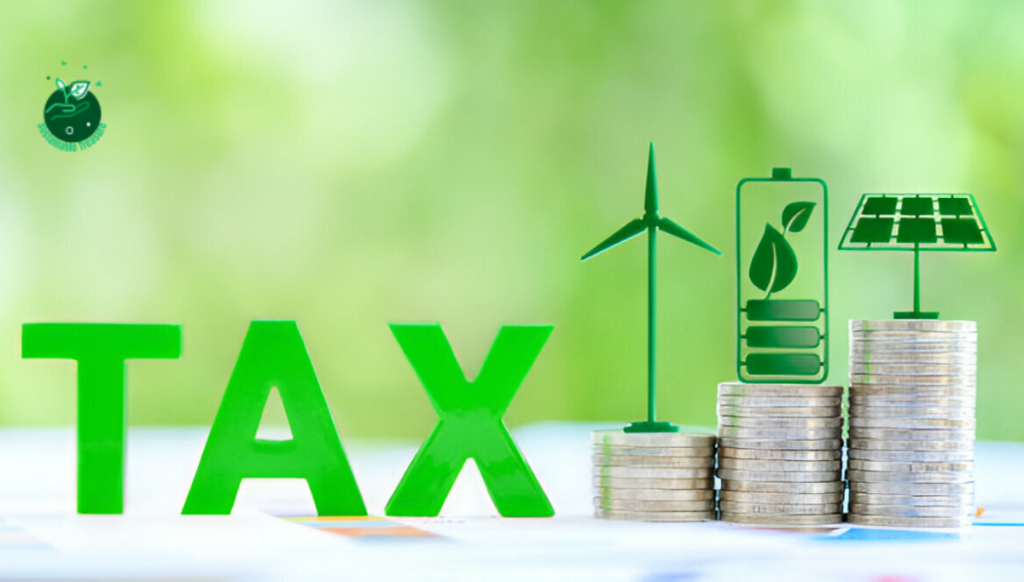Table of Contents
Did you wish to know how renewable energy tax credits work? They’re financial incentives that make going green much more affordable.
When I was a kid, my parents installed solar panels despite the huge upfront cost because they cared about the environment.
I’ll never forget my dad’s relieved smile after claiming the federal solar tax credit – it made that investment feasible for our middle-class family.
That’s the power of renewable energy tax credits. They open doors to sustainable living that may otherwise seem out of reach financially.
Drawing from my own experience with an Experienced tax professional, years of Energy policy analysis, and Authority guidelines, I’ll guide you through these Trustworthy tax benefits step-by-step.
Get ready to become a renewable energy tax credit expert! It’s easier than you think to save money while saving the planet.
So what exactly are renewable energy tax credits? Essentially, they are dollar-for-dollar reductions in the income tax you owe to the federal government.
By installing qualifying renewable energy systems at your home or business, you can claim these credits and receive a nice tax break.
The main goal of renewable energy tax credits is to incentivize consumers and companies to increase their use of clean, sustainable energy sources like solar, wind, geothermal, and biomass.
More renewable energy adoption means reducing our reliance on dirty fossil fuels and cutting harmful greenhouse gas emissions. It’s a win-win for your wallet and the environment.
Types of Renewable Energy Tax Credits

There are several different renewable energy tax credits available depending on the type of system you install and whether it’s for residential or business use. Here are some of the biggest ones:
Solar Tax Credits
One of the most popular renewable energy tax credits is for solar photovoltaic systems that generate electricity from the sun’s rays. The federal solar tax credit currently offers a 30% tax credit on the cost of installing eligible solar energy systems on residential and commercial properties.
For example, if you spend $20,000 installing solar panels on your roof, you could receive a tax credit of $6,000 (30% of $20,000)! This federal solar tax credit is available through 2032 for residential systems, while the commercial credit has no set expiration date yet.
| Solar System Cost | 30% Federal Tax Credit |
|---|---|
| $10,000 | $3,000 |
| $15,000 | $4,500 |
| $20,000 | $6,000 |
| $25,000 | $7,500 |
Pretty awesome, right? Many states also offer additional solar tax credits on top of the federal incentive.
Wind Power Tax Credits
If you live in a windy area, you may want to consider installing a small wind turbine system to generate clean electricity. Residential wind turbines qualify for the same 30% Residential Clean Energy Credit from the IRS as solar.
Commercial-scale wind farm projects are eligible for the Renewable Electricity Production Tax Credit based on every kilowatt-hour of energy produced.
Geothermal Tax Credits
Another renewable energy source seeing a tax credit boost is geothermal heating and cooling systems. These systems use the Earth’s internal heat for heating and air conditioning rather than fossil fuel furnaces or electric air conditioners.
Both residential and commercial geothermal heat pump systems are covered under the 30% Residential Clean Energy Credit and Investment Tax Credit, respectively. The credits cover the cost of installing the indoor and outdoor equipment, drilling, piping, wiring, and labor.
Biomass Tax Credits
The often overlooked biomass energy sector also qualifies for federal tax credits. This includes systems that burn organic plant or animal waste to generate electricity.
The Renewable Electricity Production Tax Credit provides a per-kilowatt-hour credit for electricity generated by biomass combustion systems. There are specific guidelines on what biomass fuel sources qualify.
| System Type | Tax Credit |
|---|---|
| Residential Solar PV | 30% of total system cost |
| Commercial Solar PV | 30% of total system cost |
| Small Residential Wind | 30% of total system cost |
| Commercial Utility-Scale Wind | Tax credit per kWh of electricity produced |
| Geothermal Heat Pumps | 30% of total system cost |
| Biomass Combustion Systems | Tax credit per kWh of electricity produced |
As you can see, there are generous renewable energy tax credits available for a wide variety of clean power systems.
Eligibility Criteria for Renewable Energy Tax Credits
Of course, not every renewable energy installation qualifies for these lucrative tax credits. Each type of credit has specific eligibility requirements you must meet:
For the Residential Clean Energy Credit, your renewable system must be installed at your principal residence located in the U.S. The credit covers:
- Photovoltaic solar panels
- Solar water heating systems
- Small wind turbines
- Geothermal heat pumps
- Biomass fuel stoves and systems
The Investment Tax Credit is available for commercial renewable energy systems installed at businesses in the U.S. Qualifying technologies include:
- Solar power
- Fuel cells
- Small wind turbines
- Geothermal systems
- Combined heat & power
- Microturbines
There are additional stipulations on system size caps, performance metrics, and other criteria. Be sure to review the latest IRS guidelines and speak with a tax professional to ensure your system meets all requirements before claiming credits.
How to Claim Renewable Energy Tax Credits

Claiming renewable energy tax credits is relatively straightforward if you have all your documentation in order. Here are the key steps to take:
- Obtain Certification Statement for Your System
The IRS requires you to submit a certification statement from the manufacturer certifying your system meets the tax credit requirements. - Complete IRS Tax Credit Forms
- For residential systems, file IRS Form 5695 as part of your annual federal tax return.
- Businesses will need to file IRS Form 3468 to claim the Investment Tax Credit.
- Provide Proof of Expenditures
You’ll need to submit documentation verifying your total system cost, such as invoices, receipts, and other paperwork from your installer. - Claim Tax Credits or Carry Forward
Once your return is processed, you can claim the tax credit amount against what you owe in federal taxes. If the credit exceeds your tax liability, you may be able to carry forward the balance to future years, depending on the specific credit guidelines.
It’s crucial to retain all your renewable energy system documentation for at least three years for potential IRS audits down the road.
Pro Tip: Work with a qualified tax professional familiar with renewable energy tax credits to ensure you comply with all rules and maximize your financial benefits.
Benefits of Renewable Energy Tax Credits
The main appeal of renewable energy tax credits, of course, is the potential tax savings on your annual IRS bill. Install a residential solar system, and you could knock off thousands in federal income taxes you owe! For businesses, the credits can significantly reduce capital costs of building renewable energy plants.
But the benefits extend far beyond just financial incentives:
- Accelerate Renewable Energy Adoption
Tax credits make clean energy technologies more affordable, driving demand and accelerating the transition from fossil fuels. - Support Domestic Green Energy Industries
The renewable energy sector creates thousands of good local jobs that can’t be outsourced. Tax incentives help grow these businesses. - Reduce Carbon Footprint & Air Pollution
Every kilowatt-hour generated from wind, solar, and other renewables prevents greenhouse gas emissions from power plants. - Hedge Against Rising Electricity Costs
Producing your own renewable electricity locks in low energy rates compared to utility rates that continually increase. - Increase Property Values
Homes and commercial buildings with renewable systems often have higher market values and sell faster.
There’s never been a better time to go green! With renewable energy tax credits helping make the finances work out, investing in clean energy is a no-brainer.
FAQs
How Long Do Renewable Energy Tax Credits Last?

- The Residential Clean Energy Credit currently extends through December 31, 2034, though credit values begin stepping down annually after 2032.
- The federal Investment Tax Credit has no set expiration date currently for most technologies, though solar ITC will phase down to a permanent 10% credit after 2024.
Always check for the latest updates, as these credits are periodically renewed or adjusted by Congress.
Are Renewable Energy Tax Credits Refundable?
Most renewable energy tax credits are non-refundable, meaning they can only be used to offset your tax liability to zero for that year. However, any remaining credit amount can typically be carried forward to future tax years.
The exception is the Residential Clean Energy Credit, which does allow the remaining credit value to be refunded to you as a payment if it exceeds your tax liability.
Can Businesses Benefit from Renewable Energy Tax Credits?
Absolutely! In fact, businesses can take advantage of additional tax incentives renewable energy projects that residential taxpayers cannot claim. The federal Investment Tax Credit mentioned previously is specifically for commercial renewable energy systems like solar farms, industrial wind turbines, fuel cell plants, and more.
Many states also offer incentives targeted at businesses installing renewable energy. For example, Property Assessed Clean Energy (PACE) financing allows companies to borrow money for energy upgrades and repay it through property tax assessments.
What Happens if I Don’t Use All My Renewable Energy Tax Credits?
For most renewable energy tax credits, any remaining balance of credits can be carried forward to future tax years if your liability was less than the full credit value.
The residential solar tax credit carryforward period is unlimited until the credits are exhausted. Other credits may have shorter timeframes you can roll over the balance, so check the specific guidelines.
Worst case, any credits you can’t use do expire after the specified carry forward period ends. But an experienced tax preparer can help you maximize the credits over multiple years.
What Renewable Energy Tax Credits Are Available For 2023?
The two main federal renewable energy tax credits available in 2023 are:
- The Residential Clean Energy Credit: This provides a 30% tax credit for homeowners installing solar panels, solar water heaters, wind turbines, and geothermal heat pumps.
- The Investment Tax Credit: Allows businesses a 30% tax credit for installing solar, fuel cells, geothermal, wind, and other renewable energy systems.
What Tax Credits Are There For Solar Panels?
The federal Residential Clean Energy Credit provides a tax credit of 30% of the total cost of installing residential solar photovoltaic (PV) panel systems. This solar tax credit applies to both rooftop and ground-mounted solar panel installations through 2032.
Do Wind Turbines Qualify For Tax Credits?
Yes, certain small wind turbines can qualify for valuable tax credits:
- Residential: The Residential Clean Energy Credit covers 30% of the cost of installing a small wind turbine at your home.
- Commercial: Utility-scale wind farms may be eligible for the Renewable Electricity Production Tax Credit based on the amount of electricity produced.
What Is The Federal Tax Credit For Energy Efficiency?
The federal tax credits specifically for energy efficiency home improvements are more limited compared to renewable energy. The Nonbusiness Energy Property Credit provides a 10% credit for installing insulation, energy-efficient windows, doors, roofs, and other upgrades to an existing home.
Conclusion
Whew, that was a ton of information to take in. But understanding renewable energy tax credits is so important for homeowners and businesses looking to affordably transition to clean energy sources.
Remember, taking advantage of these lucrative tax incentives can:
✔ Significantly reduce your tax burden
✔ Make investing in renewable technology much more cost effective
✔ Help grow the domestic green energy economy
✔ Combat climate change and air pollution
With solar, wind, geothermal, and biomass energy systems becoming more accessible and efficient than ever before, now is the ideal time to explore your renewable energy options. The combination of tax credits and long-term utility savings make the financials hard to beat.
So what are you waiting for? Call up a local renewable installer, pour over those tax credit guidelines, and get ready to embrace a cleaner, greener future. Your wallet and Mother Nature will be glad you did.
Image: Credit Istock



